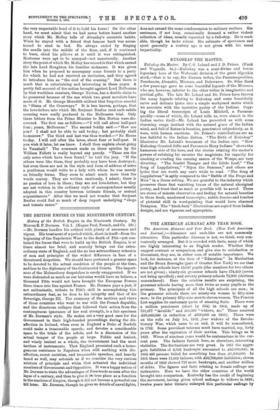THE A NTERICAN ALMANAC AND YEAR BOOK.
The American Almanac and Year Book. (New York American and Journal.)—Almanacs and such-like are not commonly attractive. This particular Almanac is not, we think, very con- veniently arranged. But it is crowded with facts, many of which are highly interesting to an English reader. Whether they suggest contrast or comparison, and give rise to satisfaction or discontent, they are, in either case, of notable importance. We look, for instance, at the item of "Education." In Manhattan and the Bronx Boroughs (part of Greater New York) we see that nine high schools have 13,047 pupils (the numbers for two others are not given) ; ninety-six grammar schools have 174,419 (seven not being specified) ; and seventy primary schools 72,903 (thirteen unnumbered). Here the relative results are surprising, the grammar schools having more than twice as many pupils as the primary. The principals of all the high schools are men ; in the grammar schools there are ninety-six women to fifty-nine men; in the primary fifty-nine men to eleven women. The Pension List supplies its customary quota of amazing facts. There were a million pensioners (short by 554) in 1902, made up of 731,077 " invalids " and 268,369 "widows, 8-e." These received £.28,000,000 (a reduction of £200,000 on 1901). There were on the rolls on July 1st, 1902, four widows of the Revolu- tionary War, which came to an end, it will be remembered, in 1782. Some provident veterans must have married, say, forty years after the expiration of their service. This brings us to 1822. Wives of nineteen years would be centenarians in the cur- rent year. The failures furnish here, as elsewhere, interesting statistics. The fluctuations are very great. In 1861 the aggre- gate liabilities of 6,693 bankrupts amounted to £42,000,000; in 1863 495 persons failed for something less than £1,300,000. In 1901 there were 11,002 failures, with 422,700,000 liabilities; eleven months of 1902 showed 718 more bankrupts, and another million of debts. The figures and facts relating to female suffrage are instructive. Here we have the other countries of the world brought into comparison. Kentucky has the credit of beginning the movement, having given school suffrage to widows in 1838; twelve years later Ontario enlarged this particular suffrage by Including women generally. Municipal suffrage was given by New South Wales in 1867, and by England in 1869. In the same year Wyoming gave women full suffrage. Colorado followed this example in 1893, as also did New Zealand. Two more States of the 'Union (Utah and Idaho) have done the same. The compilers of the Almanac are very enthusiastic about the results, some of which they enumerate ; reform by legislative enactment is not, however, always a suecess. But we must not discuss this or other topics. Enough has been said to show that the American Almanac is a treasury of interesting facts.



























































 Previous page
Previous page